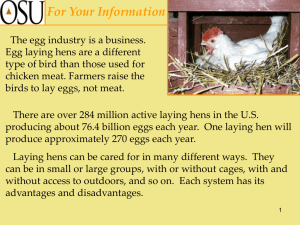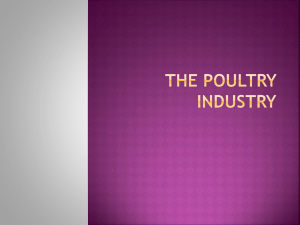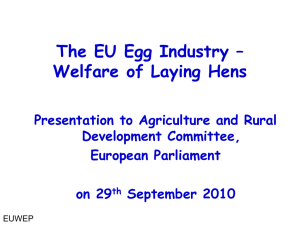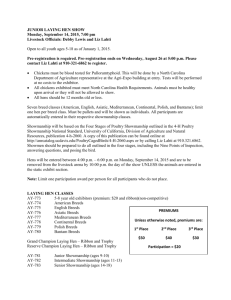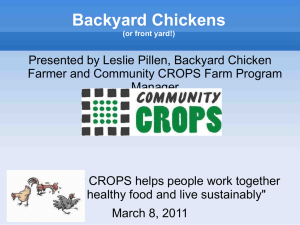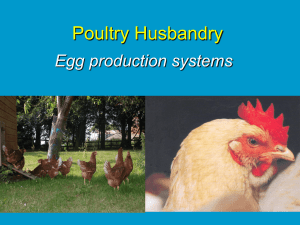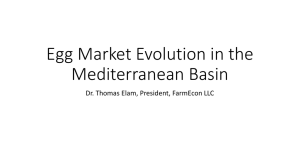breeding strategies in poultry for genetic adaptation to the organic
advertisement
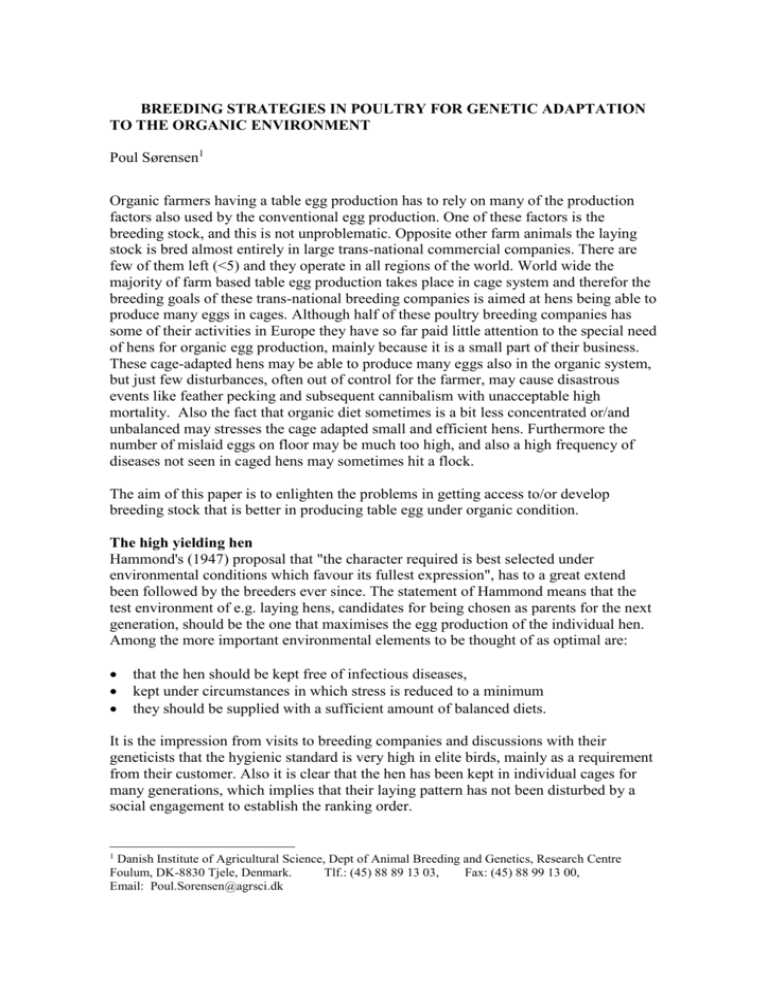
BREEDING STRATEGIES IN POULTRY FOR GENETIC ADAPTATION TO THE ORGANIC ENVIRONMENT Poul Sørensen1 Organic farmers having a table egg production has to rely on many of the production factors also used by the conventional egg production. One of these factors is the breeding stock, and this is not unproblematic. Opposite other farm animals the laying stock is bred almost entirely in large trans-national commercial companies. There are few of them left (<5) and they operate in all regions of the world. World wide the majority of farm based table egg production takes place in cage system and therefor the breeding goals of these trans-national breeding companies is aimed at hens being able to produce many eggs in cages. Although half of these poultry breeding companies has some of their activities in Europe they have so far paid little attention to the special need of hens for organic egg production, mainly because it is a small part of their business. These cage-adapted hens may be able to produce many eggs also in the organic system, but just few disturbances, often out of control for the farmer, may cause disastrous events like feather pecking and subsequent cannibalism with unacceptable high mortality. Also the fact that organic diet sometimes is a bit less concentrated or/and unbalanced may stresses the cage adapted small and efficient hens. Furthermore the number of mislaid eggs on floor may be much too high, and also a high frequency of diseases not seen in caged hens may sometimes hit a flock. The aim of this paper is to enlighten the problems in getting access to/or develop breeding stock that is better in producing table egg under organic condition. The high yielding hen Hammond's (1947) proposal that "the character required is best selected under environmental conditions which favour its fullest expression", has to a great extend been followed by the breeders ever since. The statement of Hammond means that the test environment of e.g. laying hens, candidates for being chosen as parents for the next generation, should be the one that maximises the egg production of the individual hen. Among the more important environmental elements to be thought of as optimal are: that the hen should be kept free of infectious diseases, kept under circumstances in which stress is reduced to a minimum they should be supplied with a sufficient amount of balanced diets. It is the impression from visits to breeding companies and discussions with their geneticists that the hygienic standard is very high in elite birds, mainly as a requirement from their customer. Also it is clear that the hen has been kept in individual cages for many generations, which implies that their laying pattern has not been disturbed by a social engagement to establish the ranking order. 1 Danish Institute of Agricultural Science, Dept of Animal Breeding and Genetics, Research Centre Foulum, DK-8830 Tjele, Denmark. Tlf.: (45) 88 89 13 03, Fax: (45) 88 99 13 00, Email: Poul.Sorensen@agrsci.dk The consequence in terms of genetic capacity has become a high egg-yielding hen under conditions that are optimal. That means the hen should be kept in a well-equipped cage system, have free access to a balanced diet, and having a high hygienic standard supplied with a good vaccination program. If these conditions are not met we must admit a risk because the ancestors of the hen have: not been exposed to infection pressure for many generations and therefore no direct selection for disease resistance has taken place. been selected for a high numbers of eggs laid in the individual cages, and no drive exist for the hen to go to a particular nest for laying her eggs. not been disturbed by interplay with other hens during the period they were recorded for egg laying. Therefore the ability to perform an appropriate social handling of the other hen in the flock has not been in focus at all. had free access to a balanced diet; therefore the hen may get into trouble with her laying if the feed is not optimal. Up until now it is known that: Native and local breeds not selected and the Red Jungle Fowl seem to have a better genetic resistance against infection, and often they also demonstrate a better defence and escape from predators.(experiences from rural area of developing countries) The floor laying rate of “cage adapted” breeds of laying hens was reduced to half over 5 generations of selection for laying rate in a floor system with trap-nest as will be demonstrated in a following section. When keeping hens of the high yielding breeds from international companies under floor condition in houses or in free-range systems there are too many cases in which the cannibalism and feather pecking get out of control. This will be discussed in a separate section. The Hammond thesis presupposes that no genotype environment (G E) interaction exists. Going through the literature on the subject there are many different findings, and the main conclusions are that the chance for a G E interaction increases as the difference between the environments grow and the genetic distance between the breeds is large. Indication of a G E Interaction Until 1980 it was not allowed to keep hens in cages in Denmark and up to that time some Danish breeding companies used floor systems with trap-nest to record the individual laying of hens as a criterion for selection, one of these was the Skalborg Hen. Already at that time the large international breeding companies had some parent stock in Denmark and these hybrids vent into the Random Sample Test for laying stock at Favrholm in 1978 when they were still tested in floor systems. In 1980 the ban against hens in cages was lifted and at a trial at the Random Sample Test at Favrholm, Denmark, in 1982 the same breeds/hybrids were compared in a newly established cage system (Table 1). In comparing Shaver and Lohmann with the Danish Skalborg it is obvious that 2 in the floor system the Skalborg is equal to the international breeds. When tested in cages the international breeds have expressed their full capacity for laying which are 8% larger than on floor whereas the Skalborg produces at the same rate in both environments. Looking at the relative difference between the two expressions for laying rate it was observed that Skalborg had a 5 time higher mortality in cages compared to the floor, while the international breeds had a mortality rate which was 1.5 time higher in the cages. The conclusion is that although there is no statistical significantly Hybrid Management interaction it is obvious that the Skalborg breed is genetically adapted to the floor system whereas the international breeds are genetically adapted to cage systems. Yet another comparison of a hybrid (Lohmann Brown) with various breed combinations at a further deviating environment demonstrated that the local adapted breed combination (Sonali) was considerable better than the highly improved hybrid. (Table 2). This comparison took place at the Smallholder Livestock Development Project in Bangladesh under semi-scavenging condition. This means that the hens is kept under a free range system in which they are supplied with about half of the food they need, while they have to scavenge the rest in the surrounding area. It can be observed that the Sonali hen is the best or as good as any of the other breed combinations compared. Of particular interest is that the Lohmann Brown seems poorer on laying and mortality and needed more supplementary feed than the Sonali hen. Laying stock sold by the international breeding companies has a capacity to produce above 300 eggs in 12 months, under optimal conditions placed in cages, fed a balanced diet and using optimal vaccination programmes under high hygienic standards. Results from the German Random Sample tests (Sørensen, 1997a) showed that e.g. Lohmann Brown laid 303 eggs in 12 months. The production capacity of Sonali tested in an optimal environment like the German Random Sample Test, is unknown, but it will be far below 300 eggs per hen and a bit above 200 eggs is the most likely result. Thus there are a considerable Hybrid Management Interaction or a genetic adaptation to their own environment. Behaviour traits of importance in free range/organic production When trying to perform a production system which allow hens to move around in larger flocks the following three traits seems important: 1) the ability to go to a nest before the oviposition 2) the tendency to perform feather pecking against other hens 3) the tendency to perform aggressive pecks sometimes ending with cannibalism These are all behaviour characteristics which are not exposed for the hen in an individual cage and therefor not will influence her egg laying record, but the three items will always be of importance for a hen in a floor/free range system with many hens and 3 therefor also influence her egg laying record and following the chance to be selected as a parent. Regarding nesting behaviour we had some results and experiences from a selections experiment with laying hens. The base population was in 1969 created by a cross of 7 international commercially bred laying stock. After four generations of systematic crossing the base population was divided into 5 experimental lines which for the following 6 generations were selected as C-line Control with complete random mating N-line Selected for high egg number to 42 weeks of age E-line Selected for high egg weight at the age of 38-40 weeks I1-line Selected for and index of high egg number and high egg weight I2-line Selected as I1-line In each of the lines were tested 400-500 hens for egg laying traits. The hens were kept in floor pen with 30 to 200 hens and the eggs from the individual hens were recorded on the base of those laid on the trap nest. (Sørensen et al 1980; Sørensen, 1992). Figure 1 illustrates the change in frequency of eggs laid on floor for the various selected lines in relation to the control line. The decrease in the curves for lines N, I1 and I2 are substantial and could be interpreted that these lines have got a better ability or willingness to go to the nest when laying their egg, and this effect is genetic in origin as these lines has been selected for high number of eggs laid on the nest, while the selection in the E-line was based on egg weight. It was not possible to estimate the heritability but it is not negligible, as the selected lines have reduced the frequency of floor eggs by 9% per generation compared to the control line. It has to be added that the 7 international laying stock who were the base for the control line are supposed to have been selected for high laying capacity in a cage system through several generations. The frequency of floor eggs in the control line fluctuated between 10 and 2 percentage during the experiment. The conclusion was that a certain degree of inheritance exists for the nesting behaviour. Regarding feather pecking there has been no reports demonstrating that selection for laying performance in individual cages has any correlated effect on feather pecking or cannibalism. On the other hand there has among flocks of hens in floor/free range systems been so many observations of defeathered flocks of hens and also so many reports of flocks of hens in which cannibalism has been serious that it is beyond just rare occasions. In Western Europe much concern has been on the gentle feather pecking which leads to defeathered hens, but not necessarily to cannibalism. At Hohenheim University in Germany, Dr Bessei had worked to develope equipment, which can be used in large scale to measure the bird's tendency to perform feather pecking, and he has recently presented a useful tool (Bessei et al 1997). At Research Centre Foulum in Denmark intensive studies has shown that the degree of inheritance is low (h² = 0.15), but there is prospect for a genetic improvement through breeding and selection (Kjær and Sørensen, 1997). It is later illustrated by a divergent selection experiments showing a considerable effect of selection direct for tendency to feather pecking over 3 generations (Kjær et al, 2001). See figure 2. 4 During the last few years there has been a growing interest in trying to test if there are any genetic variability, which can be used to reduce the bad habits of cannibalistic behaviour. Among those should be mentioned the work by Craig and co-workers at Purdue University which through several years has been working with problems related to aggressive peck among hens or as they term it “Beak-inflicted injuries” (BI). They ran a selection experiments based on seven generations, (Muir, 1996) in which the birds were kept in group cages with up to nine halfsib related hens in each cage, the criteria for selection was a family based index which included survival rate. After 7 generations of selection, the mortality due to cannibalism were reduced to a third of that in the nonselected control line or 17% versus 48%, when tested in 12 bird cages and without beak trimming of the hens. (Craig and Muir, 1996). Thus there is obviously a considerable genetic potential in reducing the hens disposition for performing cannibalistic behaviour - though it has not yet been tested if this change in genetic disposition also are in effect when the hens is tested under floor/free range condition. Yet another question - is the cannibalistic behaviour, defined by Craig and Muir, genetic correlated with the feather pecking behaviour as defined by several groups in Europe? Test of various breeds and breed combination At Research Centre Foulum a test of four breeds/breed combinations were performed using: ISA Brown (ISA), New Hampshire (NH), White Leghorn (WL) and the cross between NH and WL (C). Note that ISA is a hybrid widely used for commercial brown shelled egg production, while NH and WL are pure lines of the respective breeds selected moderately for production characteristics under free range conditions. The combination C is their two-line cross, applying WL as the father, used in small-scale extensive egg production in Denmark. In the laying period, from 113 days of age to the end of the experiment at 300 days of age, the hens were fed an organic diet. Hatching eggs of all genotypes were received from different parent stock farms and incubated and hatched at Research Centre Foulum. Chickens were reared from day old to 16 weeks of age in a conventional stable without access to any outdoor area. Pullets were transferred to the laying houses at 16 weeks of age. Pullets from several rearing pens were mixed so as to balance out effects of rearing pen. Eight pens were stocked with 30 ISA, 7 pens with 30 NH, 3 pens with 25 WL and 6 pens with 30 C, each. Access to a range area was given at 16 weeks of age. The first 7 days, access was limited to 6 hours in the middle of the day. Thereafter unlimited access was given. Feed was available ad libitum. Water was available ad libitum from a water tower provided with an electrical heater in case of frost. Light intensity was approximately 20 lx. Perches, 23-28 cm per bird, 95 cm above the floor, were available and each pen was equipped with 6 single nests (28 cm wide). The results of laying and mortality are shown in Table 3 and illustrates that the high yielding ISA-Brown performs better that anyone of the other breed for the first part of the production period. But they have an unacceptable behaviour that in this case resulted in a high mortality due to feather pecking. The plumage condition at 35 week shown in Table 4 is underline that ISA Brown also has the worst behaviour as was seen from Table 3. Interestingly the cross of the two breeds seems to perform more feather pecking than the pure line which indicates a negative crossing effect. 5 At the Swedish Agricultural University at Uppsala two lines (A RIR line and a WL line) has been bred for better egg production based on a diet prepared from "home grown cereals" or a low protein level (13%). This may be an advantage for organic production and there is at the moment an interest for testing that in the organic environment. This Swedish hen also termed SLU-1329 (RIR WL) so far has been tested in aviary system and in free-range system in Sweden against conventional hybrids. In the Aviary system it was compared with Lohmann LSL feeding a 15% crude protein diet (Abrahamsen and Tausen, 1998) and SLU-1329 showed a significant less rate of lay (75% versus 83 %). Under floor condition the SLU-1329 was compared to Lohmann LSL and Hisex white and Hisex brown using the low protein diet (13.5 % crude protein) and had rate of lay of 75% and 78% up to 78 weeks of age in two investigation while the international hybrids had a rate of lay of the same or significant lower. In both test the SLU-1329 had a significant better feed efficiency (Wilhelmson & Carlgren, 1996; Wilhelmson et al. 1996). Thus its seems that the Swedish Hen is a good alternative when egg production takes place with a low protein diet in floor condition. It remains to be tested in an organic condition, and in particular the problems that the two lines have been selected in cages has to be looked carefully at. In Germany test is being performing at Neu-Ulrichstein in free range /organic systems of various hybrids. Among these the Lohmann Traditional seems to be of particular interest. Conclusions Regarding access to breeding material for laying hens to organic egg production the following can be concluded: The breeding material available is genetically adapted to the cage systems This cage adapted material has a short coming regarding behaviour in larger flocks that manifest in: too high tendency to feather pecking and cannibalism, and, independent of flock size, also to many mislaid eggs. Experiments has shown that feather pecking, cannibalism and nesting behaviour can be improved by selection. A search for alternative breeds/hybrids has not yet given the ideal "Organic hen". There seem to be a possibility for adaptation of laying bird to diets with lower crude protein that makes a production possible based on "home grown" crops even in Northern part of Europe. Future Perspective There seems to be two strategies that contemporary should be in action. 1. A continuos search for breeds or lines that shows to be suitable for organic egg production. 2. Initiating a breeding programme for laying hens that takes particular care of the specific request for organic egg and meat production There has been and is still small national projects going on dealing with item 1, but little is doing regarding item 2. The question here is who is doing that job? 6 References Abrahamsson, P. and Tauson, R. 1998 Performance and egg quality of laying hens in an aviary system. Journal of Applied Poultry Science 7:225-232. Bessei W., Reiter K. and Schwazenberg A. 1997 Measuring pecking towards a bunch of feathers in individually housed hens as a means to select against feather pecking. In:Proceedings of Fifth Europeans Symposium on Poultry Welfare 1997. Eds P. Koene and H.J. Blokhuis. ISBN 90- 6754-486-8. Craig J.V. and Muir W.M. 1996 Group selection for adaptation to multiple hen cages: Beak-related mortality, feathering, and body weight responses. Poultry Science 75:294302. Hammond, J. (1947). “Animal breeding in relation to nutrition and environmental condition”, Biological Review, 22:195-213. Kjaer J. and Sørensen P. 1997 Feather pecking behaviour in White Leghorns, a genetic study British Poultry Science 38:335-343. Kjaer, J., Sørensen, P. and Su, G. 2001. Divergent selection on feather pecking behaviour in laying hens. Applied Animal behaviour Science. 71:229-239. Muir W.M. 1996 Group selection for adaptation to multiple-hen cages: Selection program and direct responses. Poultry Science 75:447-458. Neergård J. 1978 Kontrolstationen for Høns 1977/78. Report nr 479 from National Institute of Animal Science, Denmark. Neergård J. 1982 Kontrolstationen for Høns 1979/82. Report no 541 from National Institute of Animal Science, Denmark. Rahman, M., Sorensen, P., Jensen, H.A. and Dolberg, F. (1997). “Exotic hens under semi scavenging conditions in Bangladesh”, Livestock Research for Rural Development 9(3). http://www.hcm.fpt.vn/inet/lrrd/lrrd9/3/bang931.htm Sørensen, P. (1997a). “Results of the German Random Sample Tests 1995/1996”, Dansk Erhversfjerkræ, 26:239-249. Sørensen, P. (1997b). “The population of hens looses important genes. A case story”, Animal Genetic Resources, 22:71-78. A FAO publication series. Sørensen P. 1992 Selection, environments of layers and response to nesting behaviour. In: Proceedings of XIX Worlds’s Poultry Congress, Amsterdam. Vol.2:409-412. Sørensen P. Ambrosen T. and Petersen Aa. 1980. Scandinavian selection and crossbreeding experiment with laying hens. IV Results from the Danish part of the experiments. Acta Agriculturæ Scandinavica. 30:288-308. 7 Wilhelmson, M. and Carlgren, A.-B. 1996 Laying stock for the future - a comparison between and experimental cross and a commercial hybrid. Publication no 127. Swedish University of Agricultural Sciences, Dept of Animal Breeding and Genetics Wilhelmson, M., Carlgren, A.-B. and Tauson, R. 1996 Djurmaterial i den framtida æggproduktionen - en jamførelse mellen fyra hybrider. Publication no 126. Swedish University of Agricultural Sciences, Dept of Animal Breeding and Genetics 8 Figure 1. Proportion of mislaid eggs (Floor eggs) of the Selected lines as percentage of the Control line, for each generation.. Line N , I and I was selected for high number of eggs laid on the trap nest. while Line E was selected for large eggs. Floor eggs as % of control line S-lines/control 140 120 E-line 100 Control 80 I1-line 60 N-line I2-line 40 20 1 2 3 4 5 6 Generation 9 Figure 2. Effect of three generations of divergent selection for tendency to feather peck (HP line for high tendency, LP line for low tendency). Bouts per birds is series of gentle pecks performed without interruption. (Kjaer et al. , 2001) 10 Table 1. Comparison of the Danish Skalborg hen with international hybrids in 1978 in a floor system and in 1982 in a cage system. All breeds of White Leghorn type. (Neergaard, 1978; Neergaard, 1982) Hybrids Test in floor system, 1978 Test in cage system, 1982 Eggs in 365 days per hen placed Eggs in 365 days per hen day Eggs in 365 days per hen placed Eggs in 365 days per hen day Shaver 265 274 278 298 Babcock 259 264 Hisex 264 267 Lohmann 259 268 276 285 264 292 Dekalb Average of interNational hybrids 262 268 273 292 Skalborg 267 240 266 262 11 Table 2. Summary of performance of 8 different breed combinations (Rahman et al., 1997) Perfor- Lohmann (AR) mance Brown Fa st Age at 1 egg, w. FaAB RAB Sonali (FaR) RWL (RFa) AB WLAB 35 32 32 34 33 32 33 35 86b 104 ab 86 b 105 ab 119 a 97 b 86 b 99 ab 140 ab 137 b 125 b 139 ab 156 a 128 b 141 ab 139 ab 22.1 ab 35.0 b 27.6 ab 32.6 b 16.0 a 25.2 ab 21.2 ab 22.9 ab 146 b 122 a 136 ab 144 b 130 a 134 ab 146 b 135 ab Egg/hen Actuel Eggs/hen 12 month Mortality % Supplem. feed, kcal Figures with same or no superscript in a row are not significantly different Abbreviations for breed: AB = Lohmann Brown; Fa = Fayomi, R = RIR; WL = White Leghorn; A = Female of the Lohmann Brown. 12 Table 3 Egg production (given as Rate of lay, Nos. of eggs) Egg Weight and Mortality, as affected by genotype. Traits NH WL WL NH ISA-Brown P< 1 Rate of Lay, % 63.2c 72.4b 69.2b 84.6a 0.0001 Rate of lay, during January 54,2c 67,2b 61.4bc 81.4a 0.0001 Nos. of eggs, Hen placed 18-43 weeks Nos. of eggs, Hen placed 40-43 weeks Age at first egg, weeks 88.8 c 103.4b 105.5 bc 127.2 a 0.0001 11.3b 14.9ab 14.2ab 16.0a 0.0156 22.2a 22.9a 21.4b 19.8c 0.0001 Egg weight, g 54.7c 58.3ab 57.0b 59.3a 0.0001 Total Mortality, % 13.8a 6.7b 3.9b 19.9a 0.0199 Mortality- cannibalism, % 18-43 weeks 1.4b 0.0b 1.1b 16.0 c 0.0001 __________________________________________________________________________________________________________________________________ a-c 1 Estimates in a row with no common superscript differs significantly (P<0.05) Probability for F-values for effects of lines in the ANOVA. 13 Condition of plumage at 35 weeks of age 1) in the comparison of four breeds/breed combination Table 4 Treatment Genotypes ISA NH WL C P< Percent of birds with damage to plumage -total 98 31 0 70 0.001 -neck 38 12 0 2 0.01 -breast/belly 89 21 0 49 0.001 -back 82 5 0 24 0.001 -wings 18 2 0 3 0.001 -tail 36 3 0 45 0.001 14
